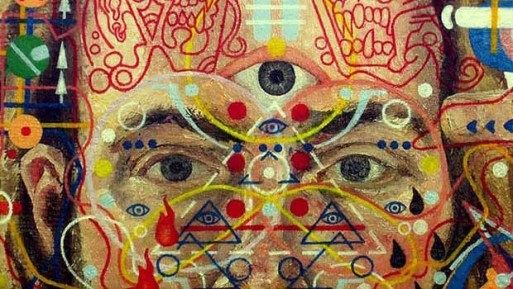Philadelphia-based artist Shawn Thornton, now 40, suffered from a cancerous tumor of the pineal gland in his 20s. Later, he channeled the pain of that experience into creating paintings that speak both to contemporary and yonder periods of art. The works wax Cubist and Surrealist, pulling motifs from Dali, Man Ray and Picasso. But they could just as easily been a part of the psychedelic art scene of San Francisco in the 60s. The moving collection speaks to the subject of art from a technical perspective and as a place of reflection on living with cancer.
“I was plagued for years with vivid, chaotic mental imagery often to the point of blacking out,” said Thornton in a 2006 email to Artblog. “And much of the symbology in my paintings came out of that struggle and the ordeal I had in dealing with the physical plane that became perversely abstracted to my mind for years. I lost a lot of simplicity.”
Thorton, uninsured and unemployed at the time of his diagnosis, says he faced “some pretty horrific medical negligence as well.”
Commenting on Thorton’s work, the Philadelphia Institute for Advanced Study said this:
“The pineal gland was once thought to be vestigial — or a wholly mysterious organ housing a divine function. A stitch that held Man to another realm. If for Thornton, that stitch came loose a little, it let in more dark light than normally permitted, in which he labored to transcribe some pretty weird intricacies. Just as, when in a lightless room— a camera obscura— we strain our eyes in order to make shapes from any small source of illumination we find.”
This is the world as seen by Shawn Thorton. Fluid yet jarring, beautiful yet chaotic. It’s the effect you’d experience after staring at a fluorescent disco ball and then squeezing your eyes shut: physical, but with a residual feeling that feels almost spiritual.
Huxley would have enjoyed analyzing Thorton’s tap dance between what we’re expected to see, what we perceive, and how the two become influenced by our emotions. There is anger and acceptance in the collection’s vibrant color palette, suffused with hot shades of red and yellow. Yet the added traces of blue and the less geometric portraits speak to a more pensive mind — one that is in the process of trying to understand and overcome the nightmare of a cancerous tumor.

 Eye of the Storm: Shawn Thornton Paints His Cancer
Eye of the Storm: Shawn Thornton Paints His Cancer





 John Mulaney’s “Funeral Planning” on Netflix: No Real Plan
John Mulaney’s “Funeral Planning” on Netflix: No Real Plan

 Composting Bodies Is Now Legal in a Dozen States
Composting Bodies Is Now Legal in a Dozen States














